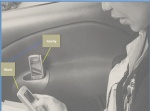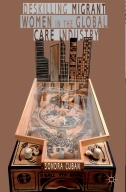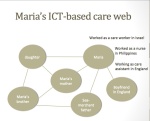 Here is Alice, a care worker in her car in England surrounded by family from all over the world, even though you can’t see them. Her car, looking like a mobile office, sounded like a disco with different rings and vibrations as family called from abroad on the phone in the car door to ask favours and chat in tune with colleagues and supervisors who called and texted her on the phone in her hand to switch routes. When I drove around with her for a year to understand her paid care for the elderly, I discovered her unpaid care for family overseas. As a self-sufficient bring-your-own-device migrant Alice was part of (excuse the jargon here) SoLoMo (social, local, and mobile) cultures bundling her ICTs.
Here is Alice, a care worker in her car in England surrounded by family from all over the world, even though you can’t see them. Her car, looking like a mobile office, sounded like a disco with different rings and vibrations as family called from abroad on the phone in the car door to ask favours and chat in tune with colleagues and supervisors who called and texted her on the phone in her hand to switch routes. When I drove around with her for a year to understand her paid care for the elderly, I discovered her unpaid care for family overseas. As a self-sufficient bring-your-own-device migrant Alice was part of (excuse the jargon here) SoLoMo (social, local, and mobile) cultures bundling her ICTs.
A participant in an Economic and Social Research Council (ESRC)-based study that I conducted from 2007-2010, Alice is representative of the other 59 migrant care workers I talked to about their lives, networks, social support systems, and uses of digital technologies.
What I mean by ICTs are audiovisual with telephone and computer networks. It is interactive, including internet-based services like Facebooking (or the like, such as nk.pl in Poland), Yahoo messaging (popular in the Philippines), skyping (world over) as well as mobile telephonies that can include the above and texting, flashing, apping, and voice messaging.
As a footnote, I’m not focusing on ICT platforms, functions or features or devices, like hand-helds or wearable computers — as cool as the iwatch sounds with its 1 and a half inch display, I’m a device and platform-agnostic and as Virginia Eubanks said: “I have bad news and good news, The “Bad news: Twitter didn’t start the Egyptian Revolution. Good news: The people did.” (http://indyreader.org/content/will-technology-save-us-all-virginia-eubanks-digital-dead-end)
I’m also not focusing on technology diffusion/adoption or the benefits of hi-tech for families or even access and distribution— Eubanks spotlights a digital dead end (2012), discussing the distribution trick. Migrant workers and their away-families are often in the forefront of adoption out of necessity.
Last but not least I am not talking about instructional design for educational technology or even MOOCS or edupunk to resist this–there is lots of research on this from Yrjo Engstrom (2011) who wants mobile learning to be like flash mobs or Anya Kamenetz focusing on DIY Universities (2011).
I am talking about usage, connecting it to mobilities, affect and social presence in socio-historical and political contexts. Back to the participants. Their stories of using these social technologies are profiled in a book I wrote this year called, Deskilling Migrant Women in the Global Care Industry (Palgrave Macmillan) .
Let me say a word about the cover. This wooden pinball machine, entitled ‘Wheel of Fortune’ by Cuban artist Abel Barroso in a series called ‘Pinball Emigrante’ is a type of unequal map of the world showing few economic migrants and their families have ‘the purchasing power,’ his words, to reach their dreams. If you look closer at this intricate map you see there is a north and a south and countries are divided up with numbers attached to them—you get 3 balls per game that spin in a circle but don’t be fooled, there is one route—look at the arrows that go up. In short your vocation depends on where you were born–nationality and chance trump strategy. Norte is the ultimate destination and the balls can’t go anywhere else. It’s an obstacle course where fate is sealed—the game is rigged. These migrant workers were players gaming this wheel of fortune of care work but could they circumvent this fete accomplice with their low purchasing power?
Did the balls, these ICTs, bouncing and spinning, from country to country, make a difference?
The participants in my study were using ICTs within their transnational families for exchanging information, learning and caring—everyday things. And these ICTs were layered and bundled for different purposes. One participant in my study Tina spoke with her depressed mother in Zambia on the phone for the immediate emotional effects of voice to gauge her moods and help her and emailed her brother in Canada for information about business issues.
Looking closely at these migrant workers and their away-families enabled me to get a dynamic view of ICT usage across households and borders through embedding mobilities within care and learning. These are all intertwined when it comes to transnational families
Although Alice was downwardly mobile in England, functioning as a frontline care worker not an occupational therapist educator as she was in the Philippines, she was a go-to cosmopolitan with her high digital literacy skills and access to technologies–using multiple media sources. Although few participants had smart phones— by the way that’s just branding— they used old and new technologies smartly, what I mean by this is that they were sharing, repairing and optimizing all aspects of their technologies—and they were used on the move to communicate with family abroad.
These families include fictive kin, partners, and othermothers, not just biological-based members. I relied on their views of family. Transnational families can be considered ‘familyhood’ across the miles (Bryceson & Vuolera, 2002). They are also considered part of, ‘transnational motherhood’ (Hondagnu-Sotelo & Avila, 2001), or the newer, ‘transnational fatherhood’ (Carling, Menjivar, and Schmalzbauer, 2012) and ‘transnational parenthood’ (Carling, Menjivar & Schmalzbauer, 2012). ‘Global householding’ (Hoang & Yeoh, 2012) is the latest term, emphasizing survival strategies of families with at least one member working in an advanced economy remitting. These families have ‘distributed homes’ (Williams, Anderson, & Dourish, 2008).
Transnational families have geographical locations but are not fixed in one place, as here or there because they often move and experience a blurring of boundaries in establishing a social and intimate presence with their loved ones. Parents often say, ‘I’m here but I’m there’ (Hondagnu-Sotelo & Avila, 2001). They experience this as a ‘tug-o-where’ as Judith Enriquez (2011) highlights due to the conflicts in establishing intimacy and in emotionally managing relations from far away. Location is problematic with ICTs.
It has been referred to as, ‘absent presence’ (Gergen, 2002) or what Palackal et al (2011) call ‘virtual co-presence’ or even, ‘co-presence by proxy’ (Baldassar, 2008). ICTs enable mediated interactions. Considered to be inferior to the gold standard of in-person presence or what is called, ‘pure relationships’ (Mirca & Madiniaou, 2012) with its moralistic narrative, there are many facets and these two domains often blur.
These interactions across borders enabled more movement—see this sponsorship letter of Sarah for her kids, precipitated by ICTs.
The children were not just left behind baggage or a burden (White et al, 2011; Goulbourne, 2010) but active agents, mobile and engaged. Sarah’s kids in the Philippines would request tours of her rented house on her laptop and she’d say ‘this is England!’ and they’d shout ‘let’s see our rooms!’ and ‘when can we come!’ Yet even with the transparency of webcams and skype these kids didn’t know their mother was a care worker in England not a nurse as she was in the Philippines.
So ICTs were used for impression management, or what’s called ‘netglow’ to project an ‘ideal migrant’ image (McLaren & Dyck, 2004). That’s why ICTs according to Ling and Campbell (2012) can bring us together but also tear us apart.
ICTs were often used in unequal ways and the research has shown that there are gender divisions with for example men using computers and the internet more than women for communicating. Elderly mothers, for example (as Kang 2012 and Schmalzbauer, 2004 show) were often less technologically inclined and in effect, silenced as were sometimes children as other studies show (Parrenas, 2005) because they weren’t in control of the contact, having little access, or were not able to afford calls, like Sarah’s kids who went to an internet café due to no home connections. Yet even these places are run by entrepreneurs who understand the long-distance relationships. So contact was somehow afforded across time and space, often in impromptu sites (Sharples, Taylor, and Vavuolea, 2007). These participants and their families were, as I’ll show, quite resilient.
I call this Maria’s care ‘web’ as it spins in family members over and beyond a typical family system type of triangle. This triangle implies one household with a, father a mother and a child. When the father or mother migrate, the child becomes destabilized. An othermother may step in and mediate that child’s sense of well-being (Gordon, Jordon and Yeoh, 2010). Yet this caregiver, in much of the literature, is considered a poor substitute with children paying the price. This care web represents a different configuration.
Maria was divorcing her Filipino sea-merchant husband based in the Gulf who she hadn’t seen in 13 years since the birth of her daughter with her legal savvy brother handling it. Maria wanted to marry her English boyfriend and start a second family with her daughter, currently in the Philippines. She delayed her sponsorship to time it in line with these events and because of her fears of promiscuity and drugs in English schools—by 16 she’d be mature enough to cope and in the meantime get a good Catholic education which Maria could afford by working in England. In the meantime she sponsored her brother to come to England where he also worked as a care worker. That was part of the deal.
Maria’s life was not just one transnational move as a care triangle suggests, but many— she was a non-migrant then a migrant and back again — her identity continually shifting as she moved.
Although trained as a teacher, as a single mother, she moved to Israel where other family resided to be a care worker. Returning to the Philippines when things got rough, she put herself through nursing school. At that point her mother was principally caregiving for her daughter, because Maria was working so much in the hospital. When Maria’s threshold for the dirt pay and conditions fell to new lows, she migrated to England where she could earn more as a caregiver. Here the grandmother was always active not just during a migration event and although in her mid-50s, she needed care too, as she had some health issues.
This web is a care economy involving multiple actors and exchanges. And it includes unpaid elder care not just stay-behind children.
Now what about learning? These transnational families were involved in situated, tacit, and mobile learning. Their learning through ICTs:
- Was embedded in the caring-ICTs became a ‘holding environment’ (Kegan, 1982) anchoring meaning for family and becoming a type of virtual home for those spread out around the globe. The ICTs were reliable and flexible, enabling difficult emotions to be dealt with, and allowed members to let go when they needed.
- Involved ritualized and emotive communicative practices-timed conversations could raise expectations especially mothers who often waited a whole day to speak to their children after school and pressured them for details.
- Was multi-directional and involved multiple members -it involved parents and children and fictive kin, communicating together. Ideas and help traveled in many directions from different parts of the world. Migrant workers also needed support from their families living in their natal countries as well as in other countries and were often involved in reverse remittances due to the high cost of living.
- Served to translate tacit knowledge- unofficial knowledge about health care navigation, schooling and academic literacy, and immigration are but a few examples. The ICTs enabled a hidden curriculum of transnational livelihoods when family shared details and stories and modelled what it’s like to be an immigrant and transnational. How does one become an immigrant? Or become a transnational? This is not easily explained. Using special tones of voices, pauses, laughter and other means for communicating enabled the message to come across.
- Depended on the situation or event and was historicized to the social moment and to particular family’s ways of interacting-ICTs were incorporated into familiar ways of relating and often concerned everyday topics. It was often the communication itself that mattered more than the content and was part of learning virtual intimacies. One participant said her calls to her mother consisted of trading sentiments of closeness: ‘I just talk. I cry. And sometimes I don’t want to talk because she or me is crying: ‘I miss you. “I miss you,” she says.
- Happened through conversation on the move- Recall Alice in her car. Short messages and sharings were the norm especially for migrant workers who were often given more workloads than their British counterparts and had to multi-task. Family learned about their loved ones’ lives simply by trying to schedule calls inbetween their rotas and listening to how busy they were as well as how much they were doing to survive.
ICTs within transnational families, then, were not about ‘care drain’ (i.e., the ‘Euro-orphan’ phenomenon dubbed in the media of Polish migrant workers in the UK ‘abandoning’ their children in Poland, communicating every so often) or, even, ‘care gain’ (i.e., mobile phone company ads showing fathers and sons expressing sentiments they normally wouldn’t) so much as ‘blessings and burdens’ (Horst, 2006) and created ‘contradictory mobilities’ (Madinaou & Miller, 2012).
- ICTs were not just the glue of transnationalism (Vertovec, 2004) but spurred greater movement of families as they astronauted about to help one another and were often sponsored. They were constantly on the move and lived ‘betwixt and between’ two or more worlds at once (Grillo, 2007). The ICTs, segueing from ‘holding environments’ acted as virtual homes that buffered the transitions and enabled connections, not ruling out power issues that are pervasive in proximate families.
- Time’s place in care was important as Joan Tronto (2003) found—the ICTs, through time, text, and talk were key to sustaining relations at a distance. But to do this background awareness of each other’s material worlds were necessary—this contributed to caring about family and caring for family. But this caring for was infused with power and could be seen as both micromanagement and emotional labour. Sarah, was a ‘study mother’ (Chiang, 2008), pushing her kids to achieve academically, monitoring their homework and speaking to their teachers in the Philippines. She was inculcating them with the academic, human, and cognitive capital she believed they would need to succeed, deferring her own for theirs. She even shadowed them on weekends from 6,000 miles away while they shopped, commenting on their choices. She could be considered a, ‘mom in the pocket’ (Ling and Campbell, 2012).
- The ICTs involved new ‘emotional grammars’ (Nussbaum, 2001) or ‘feeling rules’ (Hochschild, 1983) that recognized nuanced emotions and managed virtual intimacies to recreate a sense of ‘home’ — some emotions were performed while others were suppressed. This meant family from afar building on shared words, new vocabularies and interaction styles. These new registers and words for affection and gratitude as well as anger and pressure—helped to manage transnational relations and changing sense of selves and establish empathy. But alienation could result if the interactions led to social divisions or were delayed, misunderstood or premature as with drunk calling/texting and emailing (Hollenbaugh & Ferris, 2012). Phones could be constraining and act as wireless leashes because of the ways they reproduced social/gendered relations (Hjorth, 2012; Parrenas, 2005). And with disabilities like the loss of sight or hearing or hand problems, members could go from ‘connected presence’ of sunny day ICTs to a state of disillusionment and distance, increasing guilt and anxiety (Wilding, 2006), when care was hard to transmit.
- Their learnings were not about expanding networks to achieve more social or human capital so much as for closure among partners to achieve deeper and denser ties. But they weren’t just ‘telecocooning’ (Habuchi, 2005) . Operating as types of ‘mobile learning communities’ (Danaher, et al 2009), they amplified socio-cognitive exchanges such as learning new languages, or how to code-switch for example, from American English to a regional British dialect, back to Taglish to Tagalog or as with digital literacies, using acronyms as words, LOL and OMG (or my favourite, TTFN–ta ta for now), learning how to change c’s to k’s or numbers for prepositions like F2F for face to face (this term carries less weight now considering the audiovisual communication). This linguistic gifting (Ling and Campbell, 2012) occurred in what could be called, a transnational third space (Bhabha, 2009). These diasporic family systems were learning about each other’s everyday worlds in a ways that were familiar and in doing so, were expressing their language rights and sense of inclusion since they were often marginalized, albeit other co-ethnics, in their local communities.
Here I highlight the resilient and creative ways transnational families adapt to being in different time zones and places, sustaining their relationships across borders in spite of their long and difficult work schedules. If you are in a transnational family, does any of this ring a bell?


